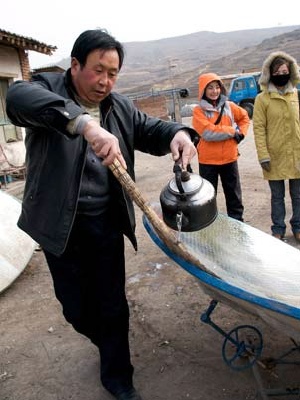Jun 15 2008
In many villages throughout Tibet, there are two ways to cook a meal. There's the traditional open fire, fueled by yak dung or the region's increasingly scarce wood. And then there are solar cookers, concentrating mirrors made of two-inch-thick concrete and covered with a mosaic of small glass mirrors.
 Tao Laoban works at cleaning one of the concrete solar cookers used in Tibet. A team of students, including some from MIT, has developed a more portable solar cooker. Photo / Scot Frank
Tao Laoban works at cleaning one of the concrete solar cookers used in Tibet. A team of students, including some from MIT, has developed a more portable solar cooker. Photo / Scot Frank
The fires produce a lot of smoke, which, especially in the confined quarters of a kitchen, can lead to lung disease. The solar cookers are clean, but so heavy that it takes four people to move one, and they have a poorly engineered focus that sometimes lights fires, cooks food unevenly or even damages metal pots.
When MIT student Scot Frank and Catlin Powers of Wellesley College visited Tibet two years ago, one thing they kept hearing from the villagers was that it would make a big difference to their lives if there was a solar cooker that was lightweight enough to be carried with them when they went off to spend the day tending their fields or their flocks, yet strong enough to stand up to the strong winds that howl across the Tibetan plateau.
A team of students from MIT and from Qinghai Normal University in Tibet's Amdo region ended up producing exactly that. The lightweight dish they produced, inspired by Tibetan nomadic tents, is made of yak-wool canvas panels, supported by bamboo ribs, and faced with reflective mylar. Easily disassembled and transported by one person, the cooker can then be quickly reassembled in the field and staked down solidly on the ground to resist the wind. In the fall, the students will begin testing their prototype in several villages, and make the design available to local factories for manufacture.
The team, called SolSource Tibet, entered MIT's annual IDEAS competition for technologies that have the potential to make significant improvements in the lives of people in developing countries, and won one of two Yunus Innovation Challenge awards, winning $3,000 to help develop the project.
Frank, a senior with a double major in biology and electrical engineering and computer science, has spent about a year and a half in the Tibet region over the last four years, and plans for the new solar cooker emerged from discussions he and Powers had with villagers there about how to improve their situations.
They then teamed up with MIT students Orian Welling, who had previously taught design fundamentals in Qinghai, was familiar with the area and has a background in photovoltaic solar design, and Brad Simpson, who has worked on research in clean-energy generation and had an interest in high-altitude problems, to work on the prototyping and actual construction of the test models. The goal was to find "improved designs and incorporate alternative materials for a more effective device, while still using local materials and production centers," Frank says.
The new cooker could find widespread application, he says, not only in Tibet but in surrounding areas in China, India, Nepal, Bhutan and Pakistan, and potentially in similar high-altitude regions in South America as well.
The solar cooker can be made for a cost of about $17, Frank says -- about the same price as the current heavy concrete model. In addition, the cookers can be fitted with an extra attachment and used to heat homes, for an additional $26 -- comparable to the cost of the non-renewable-fuel stoves they presently use for heating.
"After initial field testing this fall, we expect artisan training of the existing solar cooker factory workers to begin in January 2009 when Catlin, Brad and I will be onsite to assist in training and technology transfer," says Frank. "Our discussions with the solar cooker factory owners indicate that full-scale production could begin in summer 2009," although that may depend on the results of the field testing and any modifications that result.
And beyond that, he says, "we will be continuing with our other projects in the area: water and air-quality analysis, bilingual science book publications, and testing novel locally appropriate renewable electricity generation techniques, for which we are currently applying for patents."